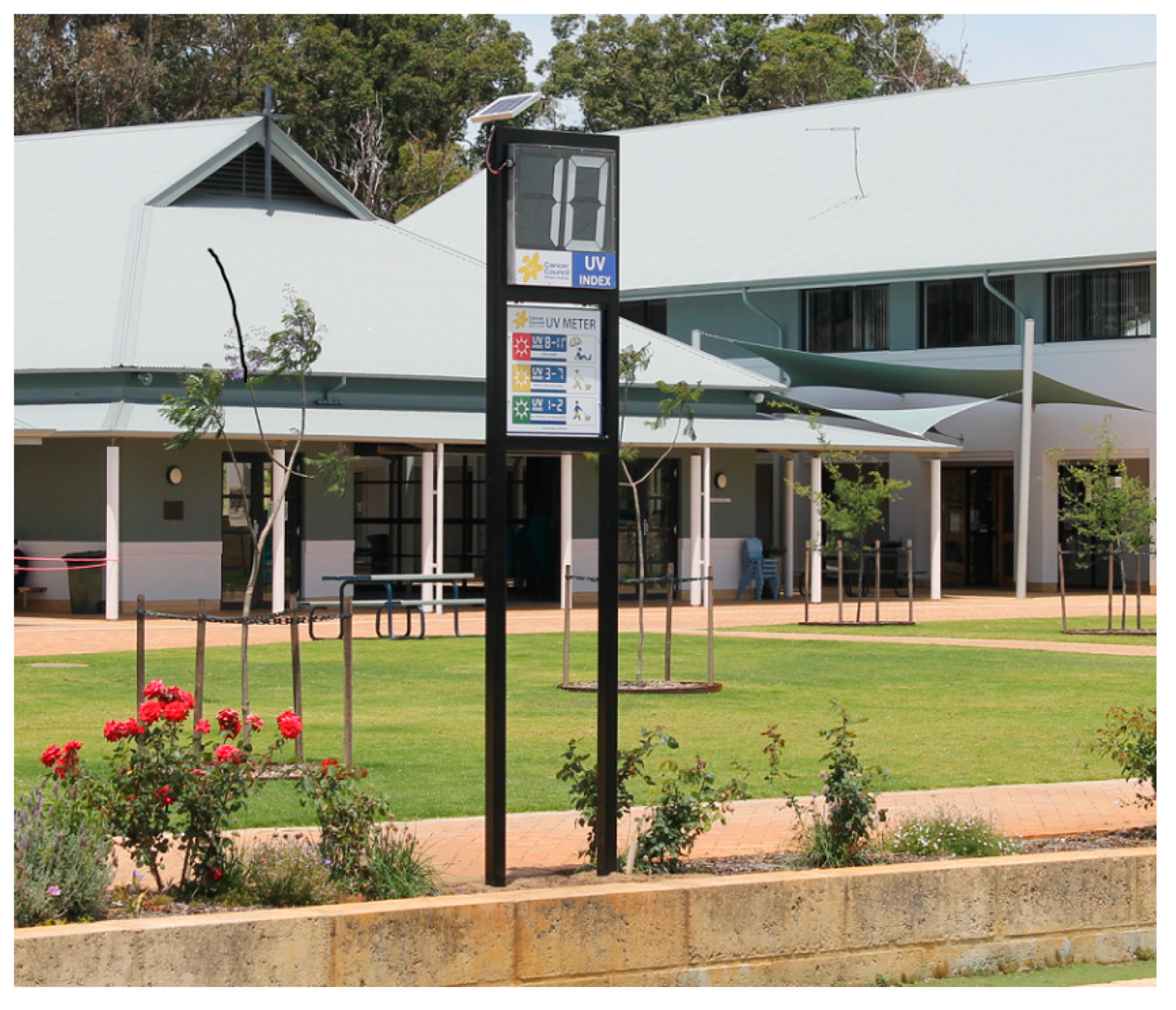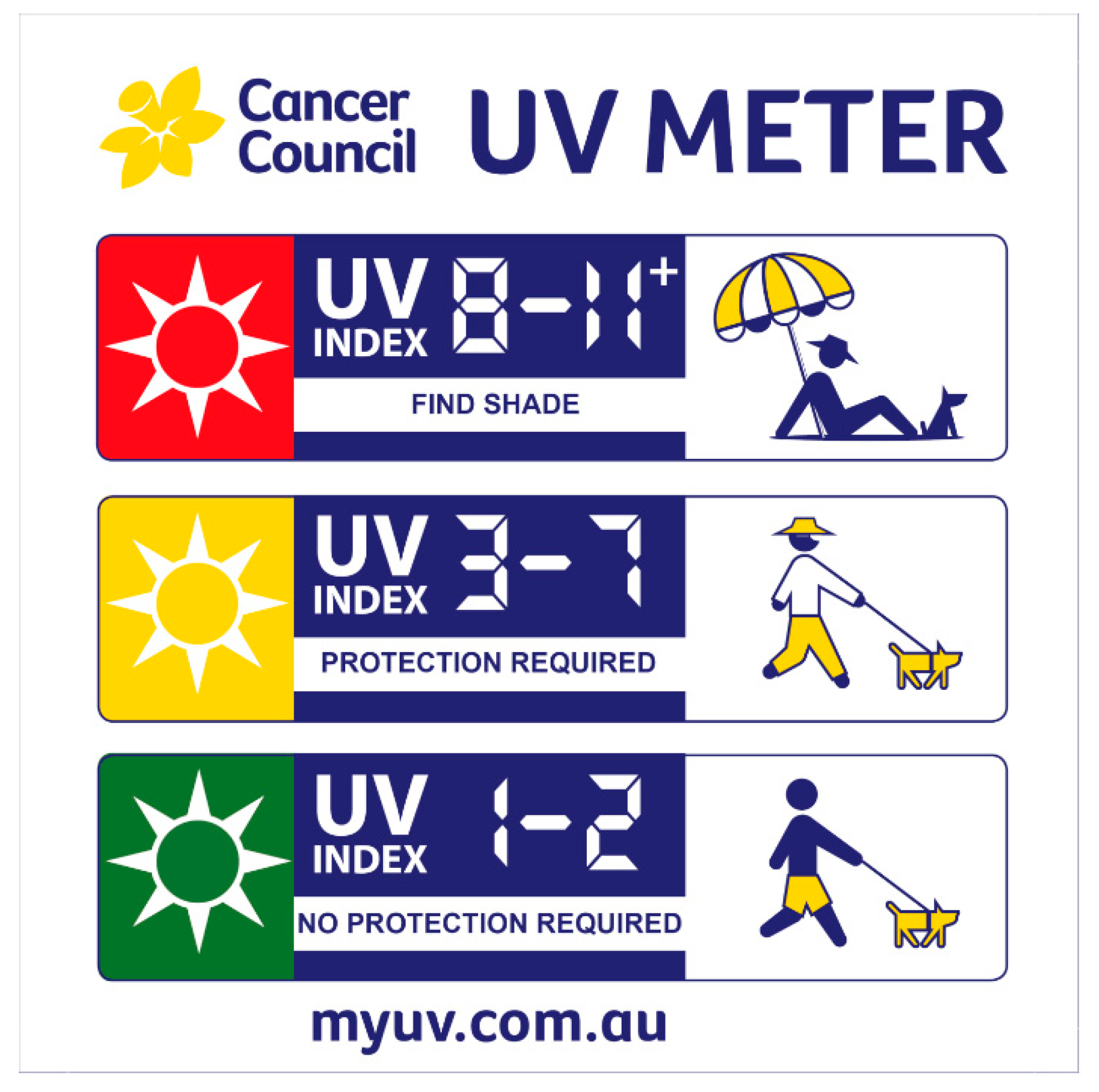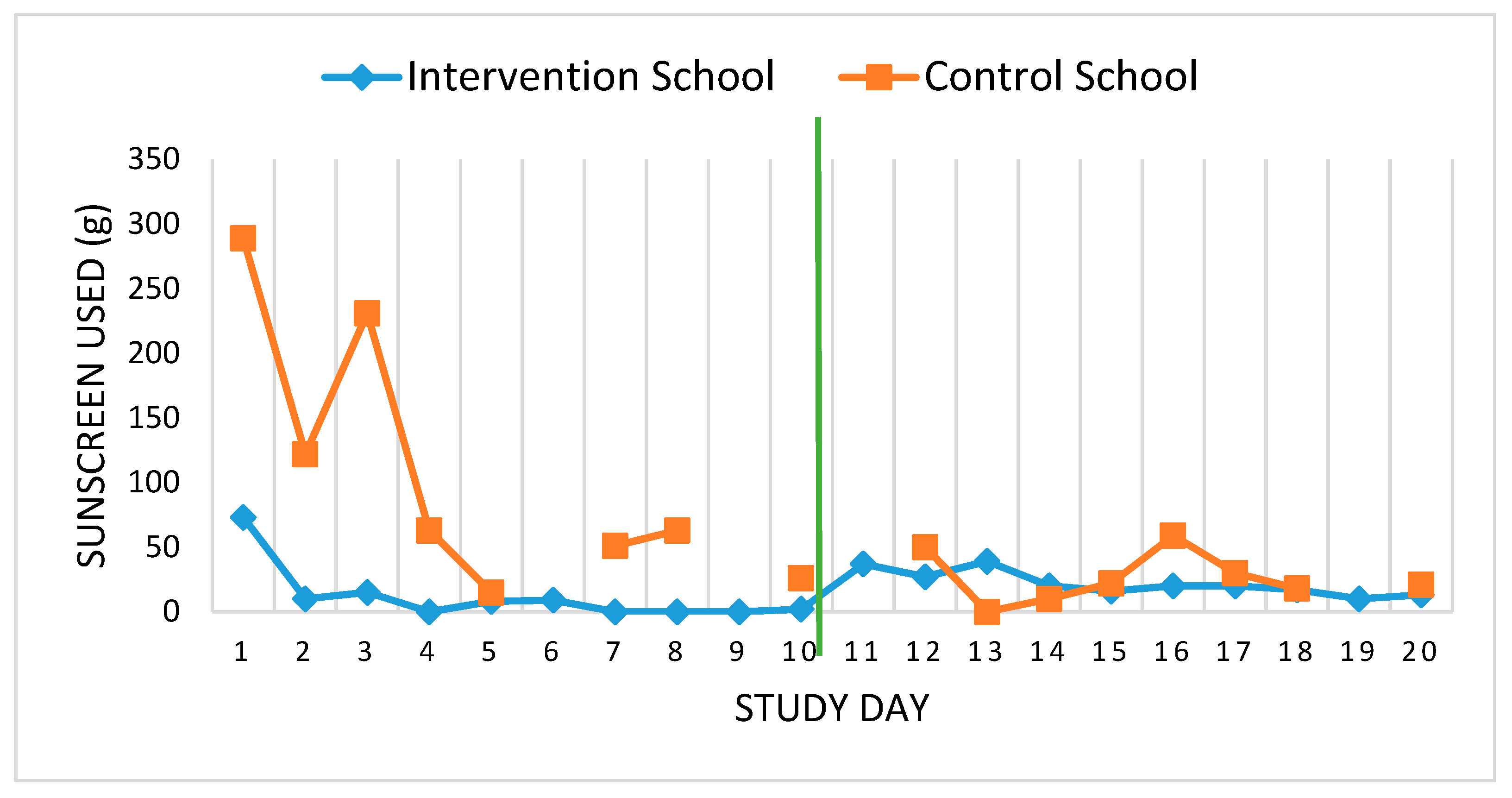The Potential of Ultraviolet Radiation Meters in Secondary Schools as a Sun Protection Intervention Mechanism for Adolescents
Abstract
1. Introduction
Present Study
2. Materials and Methods
2.1. The Intervention
2.2. Objective Data Collection
2.3. Self-Report Data Collection
3. Results
3.1. Knowledge
3.2. Attitudes
3.3. Self-Reported Behaviours
3.4. Observed Behaviours
3.5. Unsuccessful Behavioural Data Collection Methods
4. Discussion
Study Limitations and Strengths
5. Conclusions
Author Contributions
Funding
Acknowledgments
Conflicts of Interest
References
- Armstrong, B.K.; Kricker, A. The epidemiology of UV induced skin cancer. J. Photochem. Photobiol. B 2001, 63, 8–18. [Google Scholar] [CrossRef]
- Perera, E.; Gnaneswaran, N.; Staines, C.; Win, A.K.; Sinclair, R. Incidence and prevalence of non-melanoma skin cancer in Australia: A systematic review. Australas. J. Derm. 2015, 56, 258–267. [Google Scholar] [CrossRef] [PubMed]
- Staples, M.P.; Elwood, M.; Burton, R.C.; Williams, J.L.; Marks, R.; Giles, G.G. Non-melanoma skin cancer in Australia: The 2002 national survey and trends since 1985. Med. J. Aust. 2006, 184, 6–10. [Google Scholar] [CrossRef] [PubMed]
- Makin, J.K.; Warne, C.D.; Dobbinson, S.J.; Wakefield, M.A.; Hill, D.J. Population and age-group trends in weekend sun protection and sunburn over two decades of the SunSmart programme in Melbourne, Australia. Br. J. Derm. 2013, 168, 154–161. [Google Scholar] [CrossRef]
- Shih, S.T.; Carter, R.; Heward, S.; Sinclair, C. Economic evaluation of future skin cancer prevention in Australia. Prev. Med. 2017, 99, 7–12. [Google Scholar] [CrossRef]
- Holman, D.M.; Watson, M. Correlates of intentional tanning among adolescents in the United States: A systematic review of the literature. J. Adolesc. Health 2013, 52, S52–S59. [Google Scholar] [CrossRef]
- Peacey, V.; Steptoe, A.; Sanderman, R.; Wardle, J. Ten-year changes in sun protection behaviors and beliefs of young adults in 13 European countries. Prev. Med. 2006, 43, 460–465. [Google Scholar] [CrossRef]
- Autier, P.; Dore, J.F. Influence of sun exposures during childhood and during adulthood on melanoma risk. EPIMEL and EORTC Melanoma Cooperative Group. European Organisation for Research and Treatment of Cancer. Int. J. Cancer. 1998, 77, 533–537. [Google Scholar] [CrossRef]
- Force, U.S.P.S.T.; Grossman, D.C.; Curry, S.J.; Owens, D.K.; Barry, M.J.; Caughey, A.B.; Davidson, K.W.; Doubeni, C.A.; Epling, J.W., Jr.; Kemper, A.R.; et al. Behavioral Counseling to Prevent Skin Cancer: US Preventive Services Task Force Recommendation Statement. JAMA 2018, 319, 1134–1142. [Google Scholar] [CrossRef]
- Cokkinides, V.; Weinstock, M.; Glanz, K.; Albano, J.; Ward, E.; Thun, M. Trends in sunburns, sun protection practices, and attitudes toward sun exposure protection and tanning among US adolescents, 1998-2004. Pediatrics 2006, 118, 853–864. [Google Scholar] [CrossRef]
- Jones, S.E.; Saraiya, M.; Miyamoto, J.; Berkowitz, Z. Trends in sunscreen use among U.S. high school students: 1999–2009. J. Adolesc. Health 2012, 50, 304–307. [Google Scholar] [CrossRef] [PubMed]
- Koch, S.; Pettigrew, S.; Hollier, L.P.; Slevin, T.; Strickland, M.; Minto, C.; Jalleh, G.; Lin, C. Trends in Australian adolescents’ sun-protection behaviours: Implications for health campaigns. Aust. N. Z. J. Public Health 2016, 40, 468–473. [Google Scholar] [CrossRef] [PubMed]
- Tempark, T.; Chatproedprai, S.; Wananukul, S. Attitudes, knowledge, and behaviors of secondary school adolescents regarding protection from sun exposure: A survey in Bangkok, Thailand. Photodermatol. Photoimmunol. Photomed. 2012, 28, 200–206. [Google Scholar] [CrossRef] [PubMed]
- Pettigrew, S.; Jongenelis, M.; Strickland, M.; Minto, C.; Slevin, T.; Jalleh, G.; Lin, C. Predictors of sun protection behaviours and sunburn among Australian adolescents. BMC Public Health 2016, 16, 565. [Google Scholar] [CrossRef]
- Volkov, A.; Dobbinson, S.; Wakefield, M.; Slevin, T. Seven-year trends in sun protection and sunburn among Australian adolescents and adults. Aust. N. Z. J. Public Health 2013, 37, 63–69. [Google Scholar] [CrossRef]
- Hall, H.I.; Jones, S.E.; Saraiya, M. Prevalence and correlates of sunscreen use among US high school students. J. Sch. Health 2001, 71, 453–457. [Google Scholar] [CrossRef]
- Lowe, J.B.; Borland, R.; Stanton, W.R.; Baade, P.; White, V.; Balanda, K.P. Sun-safe behaviour among secondary school students in Australia. Health Educ. Res. 2000, 15, 271–281. [Google Scholar] [CrossRef][Green Version]
- Patel, A.R.; Zaslow, T.L.; Wren, T.A.L.; Daoud, A.K.; Campbell, K.; Nagle, K.; Coel, R.A. A characterization of sun protection attitudes and behaviors among children and adolescents in the United States. Prev. Med. Rep. 2019, 16, 100988. [Google Scholar] [CrossRef]
- Abroms, L.; Jorgensen, C.M.; Southwell, B.G.; Geller, A.C.; Emmons, K.M. Gender differences in young adults’ beliefs about sunscreen use. Health Educ. Behav. 2003, 30, 29–43. [Google Scholar] [CrossRef]
- Fernandez-Morano, T.; Rivas-Ruiz, F.; de Troya-Martin, M.; Blazquez-Sanchez, N.; Ruiz, M.P.; Buendia-Eisman, A. Adolescents’ Attitudes to Sun Exposure and Sun Protection. J. Cancer Educ. 2017, 32, 596–603. [Google Scholar] [CrossRef]
- Livingston, P.M.; White, V.; Hayman, J.; Dobbinson, S. Australian adolescents’ sun protection behavior: Who are we kidding? Prev. Med. 2007, 44, 508–512. [Google Scholar] [CrossRef] [PubMed]
- Potente, S.; Rock, V.; McIver, J.; Williams, M.; Magee, C.; Chapman, K. Fighting skin cancer with a musical sound: The innovative Australian sun sound campaign. Soc. Mar. Q. 2013, 19, 279–289. [Google Scholar] [CrossRef]
- Everett Jones, S.; Guy, G.P., Jr. Sun Safety Practices Among Schools in the United States. JAMA Derm. 2017, 153, 391–397. [Google Scholar] [CrossRef] [PubMed]
- Moise, A.F.; Buttner, P.G.; Harrison, S.L. Sun exposure at school. Photochem. Photobiol. 1999, 70, 269–274. [Google Scholar] [CrossRef] [PubMed]
- Diffey, B.L. Time and Place as Modifiers of Personal UV Exposure. Int. J. Env. Res. Public Health 2018, 15, 1112. [Google Scholar] [CrossRef]
- Brinker, T.J.; Faria, B.L.; Gatzka, M.; de Faria, O.M.; Heppt, M.V.; Kirchberger, M.C.; Schadendorf, D.; Nakamura, Y.; Buslaff, F.; Lisboa, O.C.; et al. A skin cancer prevention photoageing intervention for secondary schools in Brazil delivered by medical students: Protocol for a randomised controlled trial. BMJ Open 2018, 8, e018299. [Google Scholar] [CrossRef]
- Brinker, T.J.; Heckl, M.; Gatzka, M.; Heppt, M.V.; Resende Rodrigues, H.; Schneider, S.; Sondermann, W.; de Almeida, E.S.C.; Kirchberger, M.C.; Klode, J.; et al. A Skin Cancer Prevention Facial-Aging Mobile App for Secondary Schools in Brazil: Appearance-Focused Interventional Study. JMIR Mhealth Uhealth 2018, 6, e60. [Google Scholar] [CrossRef]
- Eastabrook, S.; Chang, P.; Taylor, M.F. Melanoma risk: Adolescent females’ perspectives on skin protection pre/post-viewing a ultraviolet photoaged photograph of their own facial sun damage. Glob. Health Promot. 2018, 25, 23–32. [Google Scholar] [CrossRef]
- Loescher, L.J.; Rawdin, S.; Machain, T.; Emrick, G.; Pasvogel, A.; Spartonos, D.; Johnson, R.E.; Campas, D. Implementation of Project Students Are Sun Safe (SASS) in Rural High Schools Along the Arizona-Mexico Border. J. Cancer Educ. 2019, 34, 259–268. [Google Scholar] [CrossRef]
- Persson, S.; Benn, Y.; Dhingra, K.; Clark-Carter, D.; Owen, A.L.; Grogan, S. Appearance-based interventions to reduce UV exposure: A systematic review. Br. J. Health Psychol. 2018, 23, 334–351. [Google Scholar] [CrossRef]
- Wu, Y.P.; Parsons, B.G.; Nagelhout, E.; Haaland, B.; Jensen, J.; Zaugg, K.; Caputo, H.; Lensink, R.; Harding, G.; Yancey, J.; et al. A four-group experiment to improve Western high school students’ sun protection behaviors. Transl. Behav. Med. 2019, 9, 468–479. [Google Scholar] [CrossRef] [PubMed]
- Volkov, A.; Dobbinson, S. Report 1: Skin cancer prevention knowledge, attitudes and beliefs among Australians in summer 2013–2014. In 2013–2014 National Sun Protection Survey; Cancer Council Victoria Behavioural Science Division: Melbourne, Australia, 2014. [Google Scholar]
- Tyc, V.L. Challenges in changing sun protection behaviors in children and adolescents. Transl. Behav. Med. 2019, 9, 489–492. [Google Scholar] [CrossRef] [PubMed]
- Heckman, C.J.; Liang, K.; Riley, M. Awareness, understanding, use, and impact of the UV index: A systematic review of over two decades of international research. Prev. Med. 2019, 123, 71–83. [Google Scholar] [CrossRef] [PubMed]
- White, K.M.; Zhao, X.; Starfelt Sutton, L.C.; Young, R.M.; Hamilton, K.; Hawkes, A.L.; Leske, S. Effectiveness of a theory-based sun-safe randomised behavioural change trial among Australian adolescents. Psychooncology 2019, 28, 505–510. [Google Scholar] [CrossRef] [PubMed]
- Johnson, K.M.; Jones, S.C.; Iverson, D. Guidelines for the development of social marketing programmes for sun protection among adolescents and young adults. Public Health 2009, 123, e6–e10. [Google Scholar] [CrossRef] [PubMed]
- Montague, M.; Borland, R.; Sinclair, C. Slip! Slop! Slap! and SunSmart, 1980–2000: Skin cancer control and 20 years of population-based campaigning. Health Educ. Behav. 2001, 28, 290–305. [Google Scholar] [CrossRef]
- Livingston, P.M.; White, V.M.; Ugoni, A.M.; Borland, R. Knowledge, attitudes and self-care practices related to sun protection among secondary students in Australia. Health Educ. Res. 2001, 16, 269–278. [Google Scholar] [CrossRef][Green Version]
- Koch, S.; Pettigrew, S.; Minto, C.; Slevin, T.; Strickland, M.; Lin, C.; Jalleh, G. Trends in sun-protection behaviour in Australian adults 2007-2012. Australas. J. Derm. 2017, 58, 111–116. [Google Scholar] [CrossRef]
- Blumthaler, M. UV Monitoring for Public Health. Int. J. Environ. Res. Public Health 2018, 15, 1723. [Google Scholar] [CrossRef]
- Italia, N.; Rehfuess, E.A. Is the Global Solar UV Index an effective instrument for promoting sun protection? A systematic review. Health Educ. Res. 2012, 27, 200–213. [Google Scholar] [CrossRef]
- World Health Organization. Global Solar UV Index: A Practical Guide; World Health Organization; World Meteorological Organization; United Nations Environment Programme; International Commission on Non-ionizing Radiaton Protection: Geneva, Switzerland, 2002. [Google Scholar]
- Fioletov, V.; Kerr, J.B.; Fergusson, A. The UV index: Definition, distribution and factors affecting it. Can. J. Public Health 2010, 101, I5–I9. [Google Scholar] [CrossRef] [PubMed]
- Schneider, J. The teaspoon rule of applying sunscreen. Arch. Derm. 2002, 138, 838–839. [Google Scholar] [CrossRef] [PubMed]
- Stanton, W.R.; Janda, M.; Baade, P.D.; Anderson, P. Primary prevention of skin cancer: A review of sun protection in Australia and internationally. Health Promot. Int. 2004, 19, 369–378. [Google Scholar] [CrossRef] [PubMed]
- Olson, A.L.; Gaffney, C.; Starr, P.; Gibson, J.J.; Cole, B.F.; Dietrich, A.J. SunSafe in the Middle School Years: A community-wide intervention to change early-adolescent sun protection. Pediatrics 2007, 119, e247–e256. [Google Scholar] [CrossRef]
- Williams, M.; Jones, S.C.; Caputi, P.; Iverson, D. Australian adolescents’ compliance with sun protection behaviours during summer: The importance of the school context. Health Promot. Int. 2012, 27, 15–22. [Google Scholar] [CrossRef]
- Holman, D.M.; Kapelos, G.T.; Shoemaker, M.; Watson, M. Shade as an Environmental Design Tool for Skin Cancer Prevention. Am. J. Public Health 2018, 108, 1607–1612. [Google Scholar] [CrossRef]
- Dobbinson, S.J.; Volkov, A.; Wakefield, M.A. Continued Impact of SunSmart Advertising on Youth and Adults’ Behaviors. Am. J. Prev. Med. 2015, 49, 20–28. [Google Scholar] [CrossRef]
- Walkosz, B.J.; Buller, D.B.; Andersen, P.A.; Scott, M.D.; Liu, X.; Cutter, G.R.; Dignan, M.B. Translation of a Ski School Sun Safety Program to North American Ski and Snowboard Schools. Health Promot. Pract. 2015, 16, 560–570. [Google Scholar] [CrossRef]
- Lucas, R.M.; Neale, R.E.; Madronich, S.; McKenzie, R.L. Are current guidelines for sun protection optimal for health? Exploring the evidence. Photochem. Photobiol. Sci. 2018, 17, 1956–1963. [Google Scholar] [CrossRef]
- McKenzie, R.L.; Lucas, R.M. Reassessing Impacts of Extended Daily Exposure to Low Level Solar UV Radiation. Sci. Rep. 2018, 8, 13805. [Google Scholar] [CrossRef]
- Thieden, E.; Philipsen, P.A.; Wulf, H.C. Compliance and data reliability in sun exposure studies with diaries and personal, electronic UV dosimeters. Photodermatol. Photoimmunol. Photomed. 2006, 22, 93–99. [Google Scholar] [CrossRef]



| Scale Anchors | Mean | n1 | % 1 |
|---|---|---|---|
| Useless/Useful | 4.38 | 33 | 79 |
| Unimportant/Important | 4.33 | 33 | 79 |
| Uninformative/Informative | 4.29 | 34 | 81 |
| Inconvenient/Convenient | 4.26 | 34 | 81 |
| Not worthwhile/Worthwhile | 4.12 | 30 | 71 |
| Traditional/Innovative | 3.93 | 27 | 64 |
| Boring/Interesting | 3.74 | 25 | 60 |
| Unattractive/Attractive | 3.29 | 18 | 43 |
| Outcome variables | N | % |
|---|---|---|
| Frequency of viewing the meter on an average day: | ||
| Multiple times a day | 16 | 38 |
| About once a day | 19 | 45 |
| Less than once a day | 7 | 17 |
| Never | 0 | 0 |
| Others with whom the meter was discussed: | ||
| Friends | 25 | 60 |
| Teachers | 21 | 50 |
| Family members | 18 | 43 |
| Other | 15 | 36 |
| Selected reasons | Mean | n1 | % 1 |
|---|---|---|---|
| Check the UVR index | 2.93 | 31 | 74 |
| Decide when to go in the shade | 3.00 | 30 | 71 |
| Learn about how/when the UVR index changes during the day | 2.64 | 25 | 60 |
| Decide when to wear sunscreen | 2.64 | 24 | 57 |
| Decide when to go inside | 2.50 | 22 | 52 |
| Decide when to wear a hat | 2.29 | 17 | 40 |
| Intervention School | Control School | |||||||||||||
|---|---|---|---|---|---|---|---|---|---|---|---|---|---|---|
| Pre n = 77 | Post n = 49 | Δ in Mean | Pre n = 80 | Post n = 55 * | Δ in Mean | |||||||||
| Strategy | Mean | n1 | % 1 | Mean | n1 | % 1 | Mean | n1 | %1 | Mean | n1 | % 1 | ||
| Stay in the shade | 3.71 | 51 | 66 | 3.94 | 35 | 71 | 0.23 | 3.93 | 58 | 72 | 3.80 | 39 | 71 | −0.13 |
| Use sunscreen | 2.97 | 27 | 35 | 3.00 | 17 | 35 | 0.03 | 3.16 | 33 | 41 | 3.29 | 25 | 45 | 0.13 |
| Wear a hat | 2.64 | 23 | 30 | 2.33 | 10 | 20 | −0.31 | 3.06 | 31 | 39 | 2.69 | 12 | 22 | −0.37 |
| Stay indoors | 2.84 | 21 | 27 | 2.98 | 15 | 31 | 0.14 | 3.01 | 28 | 35 | 3.24 | 28 | 51 | 0.23 |
| Wear clothes that cover your legs | 2.58 | 16 | 21 | 2.37 | 10 | 20 | −0.21 | 2.33 | 12 | 15 | 2.22 | 3 | 5 | −0.11 |
| Wear sunglasses | 1.91 | 9 | 12 | 1.67 | 5 | 10 | −0.24 | 2.23 | 14 | 18 | 2.07 | 6 | 11 | −0.16 |
| Wear clothes with long sleeves | 2.34 | 13 | 17 | 2.16 | 9 | 18 | −0.18 | 2.02 | 6 | 8 | 2.04 | 1 | 2 | 0.02 |
| Intervention School | Control School | |||||||||
|---|---|---|---|---|---|---|---|---|---|---|
| Pre | Post | Δ in % | Pre | Post | Δ in % | |||||
| Average Number of Students Per Lunch Break: | n | % | n | % | n | % | n | % | ||
| In photographed area | 37 | - | 38 | - | - | 13 | - | 12 | - | - |
| In shade | 34 | 92 | 36 | 93 | 3 | 9 | 69 | 8 | 67 | -2 |
| In sun | 3 | 8 | 3 | 7 | 0 | 4 | 31 | 4 | 33 | 2 |
| Wearing a hat | 1 | 3 | 1 | 3 | 0 | <1 | <1 | <1 | <1 | 0 |
© 2020 by the authors. Licensee MDPI, Basel, Switzerland. This article is an open access article distributed under the terms and conditions of the Creative Commons Attribution (CC BY) license (http://creativecommons.org/licenses/by/4.0/).
Share and Cite
Pettigrew, S.; Parnell, A.; Strickland, M.; Neale, R.; Lucas, R. The Potential of Ultraviolet Radiation Meters in Secondary Schools as a Sun Protection Intervention Mechanism for Adolescents. Int. J. Environ. Res. Public Health 2020, 17, 1137. https://doi.org/10.3390/ijerph17041137
Pettigrew S, Parnell A, Strickland M, Neale R, Lucas R. The Potential of Ultraviolet Radiation Meters in Secondary Schools as a Sun Protection Intervention Mechanism for Adolescents. International Journal of Environmental Research and Public Health. 2020; 17(4):1137. https://doi.org/10.3390/ijerph17041137
Chicago/Turabian StylePettigrew, Simone, Ashleigh Parnell, Mark Strickland, Rachel Neale, and Robyn Lucas. 2020. "The Potential of Ultraviolet Radiation Meters in Secondary Schools as a Sun Protection Intervention Mechanism for Adolescents" International Journal of Environmental Research and Public Health 17, no. 4: 1137. https://doi.org/10.3390/ijerph17041137
APA StylePettigrew, S., Parnell, A., Strickland, M., Neale, R., & Lucas, R. (2020). The Potential of Ultraviolet Radiation Meters in Secondary Schools as a Sun Protection Intervention Mechanism for Adolescents. International Journal of Environmental Research and Public Health, 17(4), 1137. https://doi.org/10.3390/ijerph17041137





